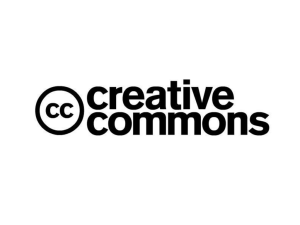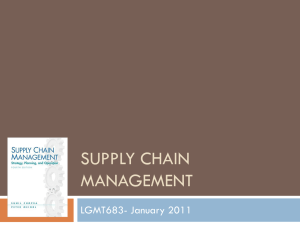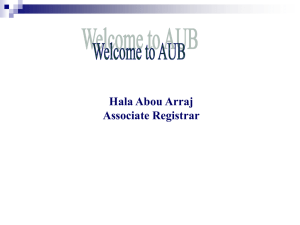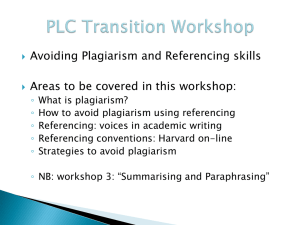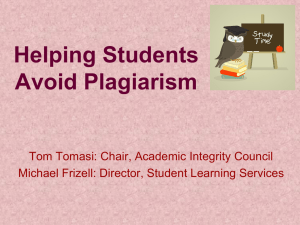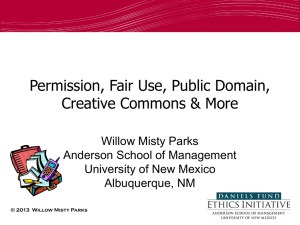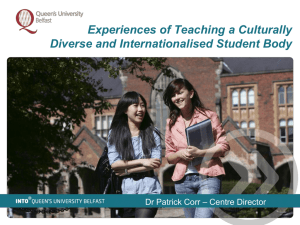Open Educational Resources by Vivien Sieber & Miriam
advertisement
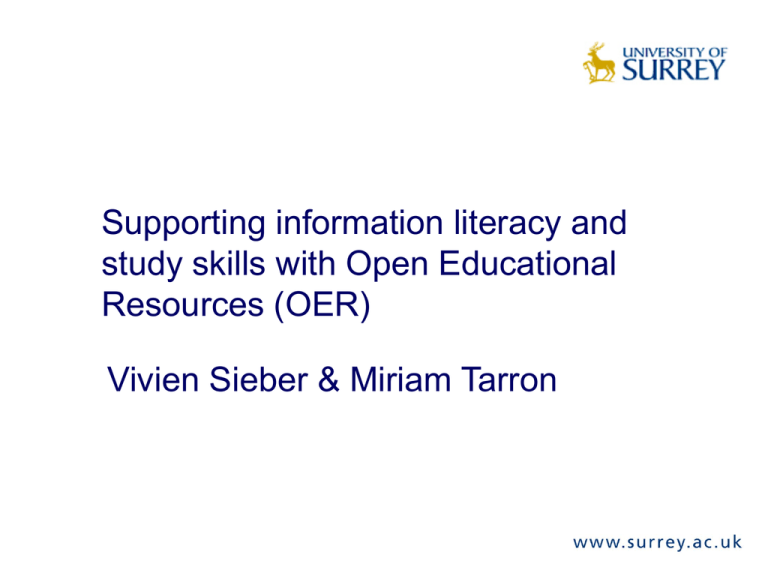
Supporting information literacy and study skills with Open Educational Resources (OER) Vivien Sieber & Miriam Tarron Who has used OERs? Open Education & OER • MIT Open Courseware Initiative (OCI) (2002) • Open Educational Resources UK • JISC/HEA projects: “What do we need to do to share and reuse courseware?” 2009-10 • Open University • Jorum (Repository) • Dependent on CC licences Advantages? Advantages • • • • • Sharing and reuse Reinventing the wheel E-learning expensive / costs Learn from others 24/7 online Creative Commons http://creativecommons.org/ • • • • Nonprofit Increase sharing & collaboration 4 types of licence (6 combinations) Author retains copyright Attribution allows • • • • • Distribution Modify, remix, derivative works Commercial use Must give credit for the original creation Most accommodating of licenses Attribution Share Alike • Distribution • Modify, remix, derivative works • Commercial use • Must give credit for the original creation • Must use the same license as original on derivative works (commercial allowed) Attribution No Derivatives • Distribution • Commercial use • Must give credit for the original creation • No derivative works, must be passed intact Attribution Non-Commercial • Distribution • Modify, remix, derivative works • No commercial use • Must give credit for the original creation • Must use the same license as original on derivative works Attribution Non-Commercial Share Alike • Distribution • Modify, remix, derivative works • No commercial use • Must give credit for the original creation • Must use the same license as original on derivative works i.e. Non-commercial Attribution Non-Commercial No Derivatives • Distribution • No modification, remix, derivative works • No commercial use • Must give credit for the original creation • Must use the same license as original on derivative works i.e. Non-commercial CC - BY Creative Commons Attribution CC – BY - ND Creative Commons Attribution No Derivatives CC – BY - SA Creative Commons Attribution Share Alike CC – BY - NC Creative Commons Attribution NonCommercial CC – BY – NC - SA Creative Commons Attribution NonCommercial Share Alike CC – BY – NC - ND Creative Commons Attribution NonCommercial Share Alike No Derivatives • Choose and agree a search term Live search or screen grab http://www.jorum.ac.uk Skills Portal • Undergraduates • Taught Masters • Doctoral Students Jorum • Download • Stylesheet • Create index • Convert from Word to HTML © University of Leicester ©University of Central Lancashire © Open University Evaluation? • Criteria? • Issues? – Technical – Pedagogy – Practical • Miriam's repurposed resource Repositories Repository Connexions Jorum Learning Resource Exchange for schools Merlot OER Commons url http://cnx.org http://www.jorum.ac. uk http://lreforschools.eun.org/ web/guest/home http://www.merlot.org/mer lot/index.htm http://www.oercomm ons.org/ Target Primary - Tertiary Further & Higher education Schools, FE Primary - Tertiary Primary - Tertiary Peer Review Community Federated searching Host country Funding blog portal wiki US Hewitt Foundation. Not for profit UK Mimas HEfCE/JISC European Schoolnet European Union (EU) US Institutional corporate partnership US Institute for the Study of Knowledge Management in Education (ISKME) Hewitt Foundation Institutional and outreach partners Construction tools Rhaptos Licensing CC Open Author CC mixed CC/copyright CC Advantages • Time • Quality • Customize - Replace institution branding - Adjust assessments - Add local instructions What would you find useful for your teaching? Where/How might you use it? http://libweb.surrey.ac.uk/library/skills/learningskills.html End Plagiarism Learning Outcomes At the end of this session you should be able to: Recall what is meant by plagiarism Consider different scenarios and judge in each case whether or not they would be classed as plagiarism Consider different scenarios and judge in each case whether or not a reference would be required What is Plagiarism? “Plagiarism is the presentation of another person’s work intentionally or unintentionally as if it were your own” University of Birmingham’s WebCT course on plagiarism. “The action or practice of taking someone else's work, idea, etc., and passing it off as one's own; literary theft.” Oxford English Dictionary. Plagiarism? Presentation created by University of Birmingham and adapted for University of Surrey students. Learning Outcomes At the end of this session you should be able to: •Recall what is meant by plagiarism •Consider different scenarios and judge in each case whether or not they would be classed as plagiarism •Consider different scenarios and judge in each case whether or not a reference would be required What is Plagiarism? The University of Surrey ‘Regulations for Academic Integrity’ defines plagiarism as: •inserting words, concepts, or images from the work of someone else into work submitted for assessment without acknowledging the originator's contribution and •representing the work of another as one's own, whether purchased or not, or taken with or without permission. •“The action or practice of taking someone else's work, idea, etc., and passing it off as one's own; literary theft.” Oxford English Dictionary. 1) It is the day before your assignment is due to be submitted. You contact an online essay writing service, which later that day (for a fee) emails you an essay that meets your requirements. The next day you submit this essay. Is this plagiarism? 1. Yes 2. No 3. Unsure 0% Un su re 0% No Ye s 0% 10 2) You have been asked to submit an essay on Romeo and Juliet and your cousin emails you her old A* essay on that topic, you make a few alterations and add a few new ideas. You submit this essay. Is this plagiarism? 1. Yes 2. No 3. Unsure 0% Un su re 0% No Ye s 0% 10 3) In your essay you discuss your own thoughts on bankers’ bonuses. Do you need to give a reference? 1. Yes 2. No 3. Unsure 0% Un su re 0% No Ye s 0% 10 4) You are writing an assignment about the British constitution and you state that the Queen is the head of state of the UK. Do you need to provide a reference for this? 1. Yes 2. No 3. Unsure 0% Un su re 0% No Ye s 0% 10 5) You include in an essay a table of data or a picture that you have found on the Web. Do you need to reference it? 1. Yes 2. No 3. Unsure 0% Un su re 0% No Ye s 0% 10 6) You paraphrase in your essay Richard Dawkins’ ideas on the transmission of cultural values from one of his popular books. Because you are not directly quoting you don’t put quotation marks. Do you need to add a reference? 1. Yes 2. No 3. Unsure 0% Un su re 0% No Ye s 0% 10 7) You and a friend are taking the same module and therefore have the same essay to write. The essay is not to be done as group work. You and your friend write your essays in the library together and end up with very similar essays. Is this plagiarism? 1. Yes 2. No 3. Unsure 0% Un su re 0% No Ye s 0% 10 8) You find a paragraph in a book that supports an argument that you are making in your assignment. You copy this paragraph into your assignment, putting quotations marks at the start and finish and provide a citation. Is this plagiarism? 1. Yes 2. No 3. Unsure 0% Un su re 0% No Ye s 0% 10 Presentation: Created by University of Birmingham as part of the DELILA project http://dspace.jorum.ac.uk/xmlui/handle/123456789/15964 This work is licensed under the Creative Commons Attribution-ShareAlike 3.0 Unported License, and adapted under this license for University of Surrey students by Miriam Tarron. To view a copy of this license, visit http://creativecommons.org/licenses/by-sa/3.0/. Title Slide photograph: Original photograph: White Sheep by Bjarki Sigursveinsson http://www.flickr.com/photos/40275507@N07/3863494118 This photograph is licensed under a Creative Commons Attribution- Share Alike 3.0 Unported License and was adapted under this license, for this presentation, by Len Tarron.
